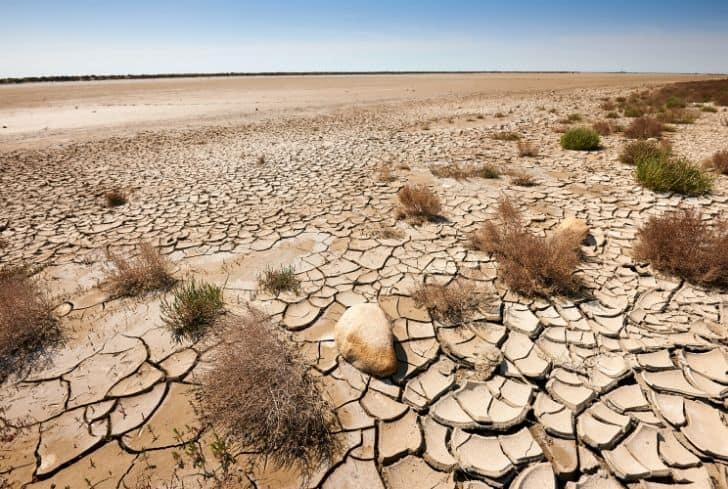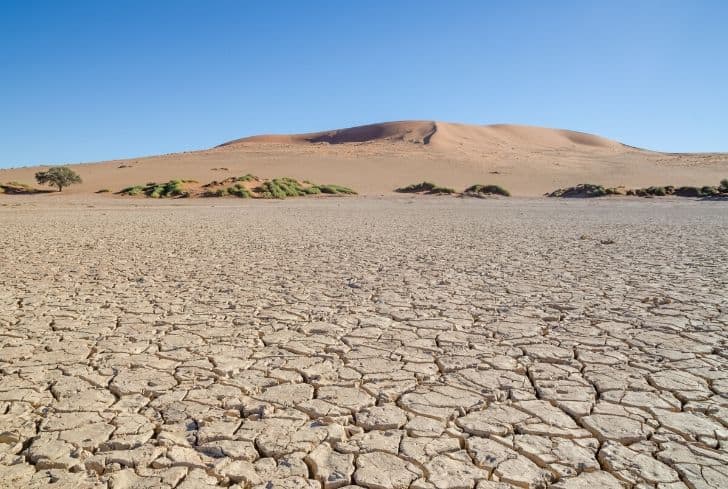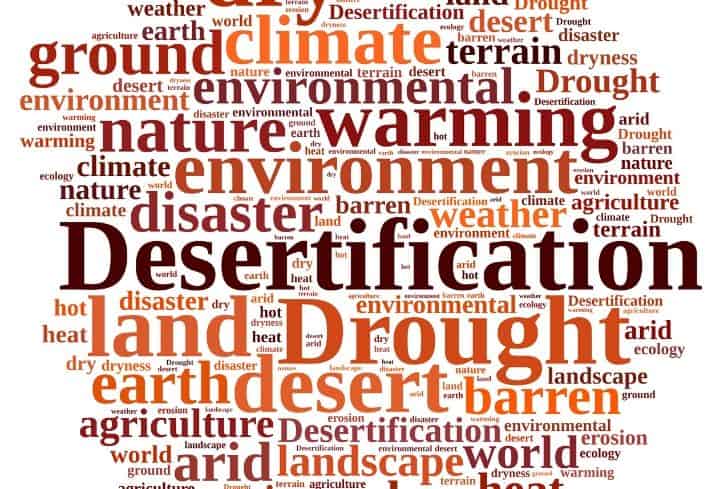Which Causes Can Be Detailed or Backed by Document J?
What is Desertification?
Desertification is defined as a process of land degradation in arid, semi-arid and sub-humid areas due to various factors including climatic variations and human activities. Or, to put it in another way, desertification results in persistent degradation of dryland and fragile ecosystems due to man-made activities and variations in climate.
Desertification, in short, is when land that was of another type of biome turns into a desert biome because of changes of all sorts. A huge issue that many countries have is the fact that there are large pockets of land that are going through a process that is known as desertification.

Overgrazing is the major cause of desertification worldwide. Other factors that cause desertification include urbanization, climate change, overuse of groundwater, deforestation, natural disasters, and tillage practices in agriculture that make soils more vulnerable to wind.
Desertification affects topsoil, groundwater reserves, surface runoff, human, animal, and plant populations. Water scarcity in drylands limits the production of wood, crops, forage, and other services that ecosystems provide to our community.
We already have the statistics for the future: the growth percentages of pollution, overpopulation, desertification. The future is already in place.
– Gunther Grass
According to UNESCO, one-third of world's land surface is threatened by desertification, and across the world, it affects the livelihood of millions of people who depend on the benefits of ecosystems that drylands provide.
Desertification is another major environmental concern and a significant barrier to meeting basic human needs in drylands and is being constantly threatened by increases in human pressures and climatic variability.
In this article, we're going to give you an idea as to what are the causes of desertification, the effects that desertification has, and what we can do in order to deal with the problem at hand. Let's take a closer look at all of these topics.
According to Wikipedia,
"Desertification is a type of land degradation in which a relatively dry land region becomes increasingly arid, typically losing its bodies of water as well as vegetation and wildlife.
It is caused by a variety of factors, such as climate change and human activities. Desertification is a significant global ecological and environmental problem."
Contents
- Various Causes of Desertification
- 1. Overgrazing
- 2. Deforestation
- 3. Farming Practices
- 4. Excessive Use of Fertilizers and Pesticides
- 5. Overdrafting of groundwater
- 6. Urbanization and Other Types of Land Development
- 7. Climate Change
- 8. Stripping the Land of Resources
- 9. Natural Disasters
- 10. Soil Pollution
- 11. Overpopulation and excessive consumption
- 12. Mining
- Devastating Effects of Desertification
- 1. Farming becomes next to impossible
- 2. Decrease in Crop Yields
- 3. Hunger
- 4. Flooding
- 5. Poor Water Quality
- 6. Overpopulation
- 7. Poverty
- 8. Biodiversity Loss
- 9. Endangerment and Extinction of Species
- 10. Destruction of Habitats
- 11. Migration
- Solutions to Desertification
- 1. Policy Changes Related to How People can Farm
- 2. Policy Changes to Other Types of Land Use
- 3. Education
- 4. Technology Advances
- 5. Restricting Mining Practices
- 6. Putting Together Rehabilitation Efforts
- 7. Reforestation
- 8. Sustainable Practices to Prevent Desertification From Happening
Various Causes of Desertification
1. Overgrazing
Animal grazing is a huge problem for many areas that are starting to become desert biomes. If there are too many animals that are overgrazing in certain spots, it makes it difficult for the plants to grow back, which hurts the biome and makes it lose its former green glory.
2. Deforestation
When people are looking to move into an area, or they need trees in order to make houses and do other tasks, then they are contributing to the problems related to desertification. Without the plants (especially the trees) around, the rest of the biome cannot thrive.
3. Farming Practices
Some farmers do not know how to use the land effectively. They may essentially strip the land of everything that it has before moving on to another plot of land. By stripping the soil of its nutrients, desertification becomes more of a reality for the area that is being used for farming.
4. Excessive Use of Fertilizers and Pesticides
The use of excessive amounts of fertilizers and pesticides to maximize their crop yields in the short term often leads to significant damages for the soil.
In the long run, this may turn from arable into arid land over time, and it will no longer be suitable for farming purposes after a few years of excessive farming since the soil has been damaged too much over time.
5. Overdrafting of groundwater
Groundwater is the freshwater found underground and also one of the largest water sources. Over drafting is the process in which groundwater is extracted in excess of the equilibrium yield of the aquifer that is pumping or the excessive pulling up of groundwater from underground aquifers. Its depletion causes desertification.
6. Urbanization and Other Types of Land Development
As mentioned above, development can cause people to go through and kill plant life. It can also cause issues with the soil due to chemicals and other things that may harm the ground. As areas become more urbanized, there are fewer places for plants to grow, thus causing desertification.
7. Climate Change
Climate change plays a huge role in desertification. As the days get warmer and periods of drought become more frequent, desertification becomes more and more eminent.
Unless climate change is slowed down, huge areas of land will become desert; some of those areas may even become uninhabitable as time goes on.
8. Stripping the Land of Resources
If an area of land has natural resources like natural gas, oil, or minerals, people will come and mine it or take it out. This usually strips the soil of nutrients, which in turn kills the plant life, and eventually leads to the process of becoming a desert biome as time goes on.
9. Natural Disasters
There are some cases where the land gets damaged because of natural disasters, including drought. In those cases, there isn't a lot that people can do except work to try and help rehabilitate the land after it has already been damaged by nature.
10. Soil Pollution
Soil pollution is a significant cause of desertification. Most plants are quite sensitive to their natural living conditions. When soil becomes polluted due to various human activities, the respective area of land may suffer from desertification in the long run. Higher the level of pollution more will be the degradation of soil over time.
11. Overpopulation and excessive consumption
Since our world population is continuously growing, the demand for food and material goods is also increasing at an alarming rate. Our overall level of consumption is also increasing at a steady rate.
Thus to fulfill our demand, we have to optimize our farming processes to harvest even higher crop yields. However, this excessive optimization of farming will hurt the soil and will eventually turn into the desertification of land in the long run.
12. Mining
Mining is another big reason for desertification. Large amounts of resources have to be extracted by industries to meet our demand for material goods. For mining, large areas of land have to be used, which causes deforestation as well as pollution of the nearby areas.
By the time most of the natural resources have been extracted, and mining practices are no more profitable, the soil gets damaged significantly, and the land becomes arid, which may not be recoverable, and desertification occurs.

Devastating Effects of Desertification
1. Farming becomes next to impossible
If an area becomes a desert, then it's almost impossible to grow substantial crops there without special technologies. This can cost a lot of money to try and do, so many farmers will have to sell their land and leave the desert areas.
2. Decrease in Crop Yields
A major effect of desertification is the decrease in crop yields. Once land turns from arable to arid, it is often on longer suitable for farming purposes anymore.
In turn, many farmers may lose their livelihood, since they often solely rely on farming as their single source of income. If their land becomes arid, they may no longer be able to provide sufficient crop yields to make a living out of it.
3. Hunger
Without farms in these areas, the food that those farms produce will become much scarcer, and the people who live in those local areas will be a lot more likely to try and deal with hunger problems. Animals will also go hungry, which will cause even more of a food shortage.
4. Flooding
Without plant life in an area, flooding is a lot more imminent. Not all deserts are dry; those that are wet could experience a lot of flooding because there is nothing to stop the water from gathering and going all over the place. Flooding can also negatively affect the water supply, which we will discuss next.
5. Poor Water Quality
If an area becomes a desert, the water quality is going to become a lot worse than it would have been otherwise. This is because plant life plays a significant role in keeping the water clean and clear; without its presence, it becomes a lot more difficult for you to be able to do that.
6. Overpopulation
When areas start to become desert, animals and people will go to other areas where they can actually thrive. This causes crowding and overpopulation, which will, in the long run, end up continuing the cycle of desertification that started this whole thing anyway.
7. Poverty
All of the issues that we've talked about above (related to the problem of desertification) can lead to poverty if it is not kept in check. Without food and water, it becomes harder for people to thrive, and they take a lot of time to try and get the things that they need.
8. Biodiversity Loss
In general, the destruction of habitats and desertification may also contribute to a loss of biodiversity. While some species may be able to adjust to the altered environmental conditions properly, many species will not be able to do so and may suffer from serious declines in population.
9. Endangerment and Extinction of Species
The desertification results in a decline in population for which species may become endangered or even extinct. This problem is especially severe for species that are already endangered as the small number of animals or plants that remains may also die off over time, which may even lead to the extinction of species.
10. Destruction of Habitats
Desertification often leads to a loss of habitats for many animals and plants. Desertification may alter the living conditions of the local flora and fauna that makes it impossible for animals and plants to sustain their populations.
After desertification, regions suffer from water shortages due to climate change and animals may suffer and die since water is vital for all life on our planet.
11. Migration
The desertification implies the destruction of the livelihood of farmers. This problem becomes even worse when large areas of land that are currently used for farming will then no longer be suitable for farming due to a lack of water triggered by global warming. This results in serious migration movements.

Solutions to Desertification
In countries where policy change will actually be enforced on those in the country, policy change related to how often people can farm and how much they can farm on certain areas could be put into place to help reduce the problems that are often associated with farming and desertification.
2. Policy Changes to Other Types of Land Use
If people are using land to get natural resources or they are developing it for people to live on, then the policies that govern them should be ones that will help the land to thrive instead of allowing them to harm the land further. The policy changes could be sweeping or they could be depending on the type of land use at hand.
3. Education
In developing countries, education is an incredibly important tool that needs to be utilized in order to help people to understand the best way to use the land that they are farming on. By educating them on sustainable practices, more land will be saved from becoming desert.
4. Technology Advances
Research is the key to overcome most of our environmental problems, and it applies to desertification also. In some cases, it's difficult to try and prevent desertification from happening.
In those cases, there needs to be research and application of the latest technology that pushes the limits of what we currently know about the drivers of desertification. Advancements could help us find more ways to prevent the issue from becoming an epidemic.
5. Restricting Mining Practices
Mining often implies the destruction of large areas of land. Therefore it should be regulated by governments to keep the nature reserves intact and protect the natural habitats of many animals and plants. Thus, less land will be arid, and the desertification issue can be mitigated to a certain extent.
6. Putting Together Rehabilitation Efforts
There are some ways that we can go back and rehabilitate the land that we've already pushed into desertification; it just takes some investment of time and money. By putting these together, we can prevent the issue from becoming even more widespread in the areas that have already been affected.
7. Reforestation
The areas that have been subject to deforestation in the past should be considered for reforestation. Planting trees in those areas are quite important since they are natural carbon dioxide storage spaces; they slow down global warming and contribute to maintaining a natural balance.
Whereas using those areas for other purposes may turn them into arid land in the long run. Therefore, planting trees in the affected areas not only prevents desertification but also fights against additional environmental issues.
8. Sustainable Practices to Prevent Desertification From Happening
There are plenty of sustainable practices that can be applied to those acts that may be causing desertification. By adding these to what we should be doing with land, we can ensure that we don't turn the entire world into a desert.
Desertification is a huge problem that needs to be addressed accordingly, and if we take the time to do it now, we can prevent other problems from happening with it in the future. By taking that critical look at desertification, we have the tools that we need in order to get through the processes effectively.
References:
Desertification
Land Degradation
Desertification and Drought Day
Which Causes Can Be Detailed or Backed by Document J?
Source: https://www.conserve-energy-future.com/causes-effects-solutions-of-desertification.php
0 Response to "Which Causes Can Be Detailed or Backed by Document J?"
Publicar un comentario